Last updated: December 6, 2023
Article
Self-Guided Tour of the Desert Research Learning Center
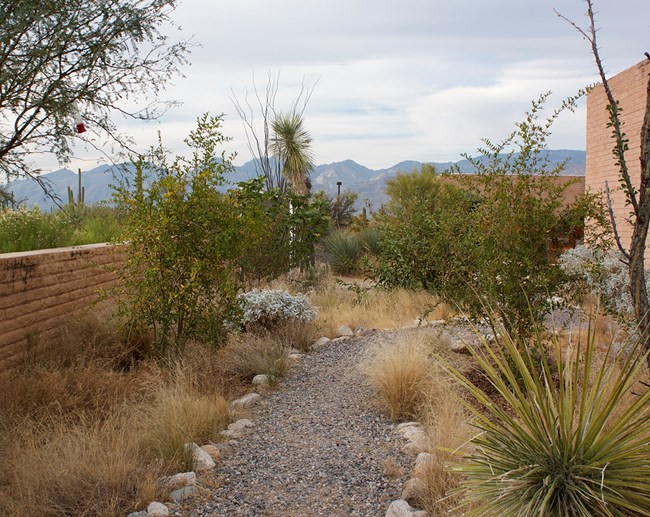
This 14-stop, self-guided tour of the DRLC grounds can be accessed by smartphone or computer. Tour stops include an artificial tinaja and flowing stream, a heritage orchard, a pollinator garden, and a variety of native plants and foods, all sustained by a rainwater collection system.
At each stop, learn how you can use your home environment to benefit native plants and animals—and even save on your water bill. Some actions are simple; others require more commitment. But all will help us to live better and longer on the land.
The tour begins at the tortoise habitat just outside the main entrance to the DRLC, then winds to the west and around the north end of the building.
Start scrolling to begin the tour!
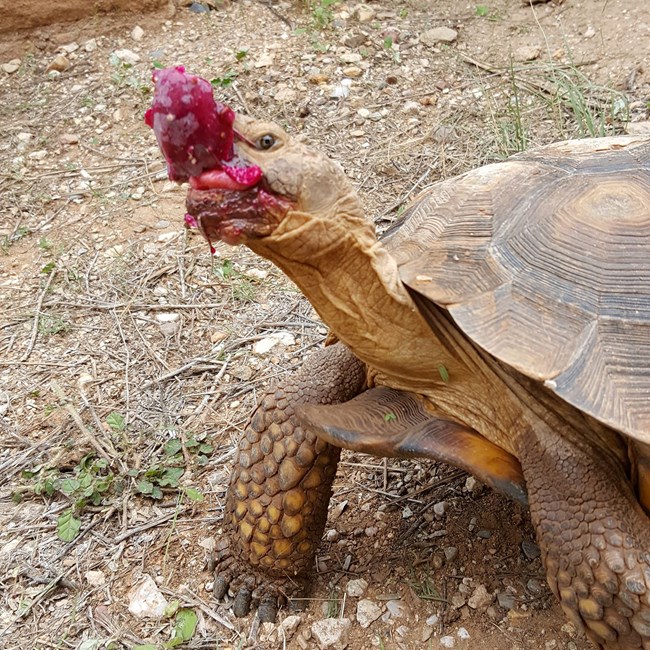
Stop 1: Desert Tortoise Habitat
This enclosure is home to "Boss Pinkley," a tortoise acquired through the Desert Tortoise Adoption Program. The program helps transfer unwanted captive desert tortoises to qualified private custodians. (It is illegal to remove tortoises from the wild, but unfortunately, this does occur. Once captive, desert tortoises cannot be re-released into the wild.)
You'll be lucky to catch a glimpse of Boss. Sonoran desert tortoises (Gopherus morafkai) spend up to 98% of their time underground, escaping either summer heat or winter cold. Their ability to dig burrows allows them to inhabit some of the most extreme environments on Earth, where ground temperatures can exceed 140°F.
Toothless, desert tortoises use their large tongues to push food to the back of their mouths. They typically eat grasses and other native plants and flowers. They can sense when rain is coming and may be found in low areas, waiting for the water to appear. Sonoran desert tortoises live on steep, rocky hillsides and in alluvial fans at the base of mountains. In the wild, they live about 50–80 years. They usually roam no further than a few miles from where they hatched but may travel much farther to locate suitable mates.
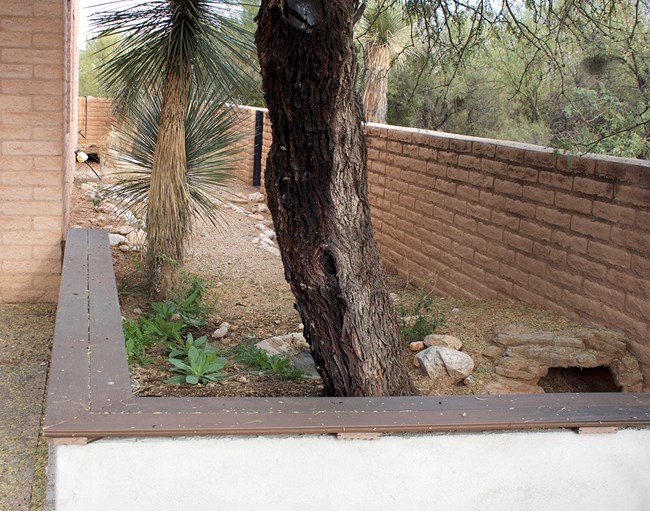
The Sonoran desert tortoise is listed as a candidate species for the threatened and endangered list. Its primary threats include habitat loss, invasive exotic species, removal of individuals from the wild, release of captive tortoises into the wild, and disease. Climate change is another significant challenge. Drought reduces available food and can cause females to lay fewer or no eggs. Prolonged high soil temperatures favor development of female tortoises, potentially leading to reproductive decline in future generations.
Keep wild tortoises wild. It is illegal to remove a tortoise from the wild in Arizona.
Keep captive tortoises captive. It is illegal to release captive tortoises into the wild. Captive tortoises released into the wild can introduce diseases that are devastating to wild populations.
Do not breed captive tortoises.
Consider joining the Desert Tortoise Adoption Program. Lawfully obtained desert tortoises may be privately adopted, subject to specific rules. This program finds suitable homes and custodians for captive desert tortoises.
Participate in the Sponsor-a-Turtle program, which helps the Arizona Game and Fish Department to purchase technical equipment used to monitor tortoise populations statewide.
Control weeds. Many non-native plants can be toxic or otherwise dangerous for desert tortoises, such as split grass (Schismus barbatus), Russian thistle (Salsola tragus), red brome (Bromus madritensis rubens), and cheatgrass (Bromus tectorum).
Practice responsible vehicle use. To preserve tortoise habitat, stay on authorized roads and trails and do not trample vegetation.
Watch and enjoy, but avoid contact. If you observe a desert tortoise in the wild, consider yourself wildly fortunate and let it be. Human handling can be deadly for wild tortoises. The one exception to this rule is if a tortoise is in harm’s way trying to cross a road. If it is safe to do so, gently lift the tortoise high enough so its feet are just above the ground and transport the tortoise across the road in the direction it was heading.
- Tortoises live exclusively on land. Turtles live in water some of the time
- Tortoises have elephantine (columnar) hind limbs and feet. A turtle’s front legs are flipperlike; a tortoise’s are not.
- Tortoises are generally vegetarians. Turtles tend to be omnivores, eating both plants and small animals.
In 1901, Frank Pinkley started work as the first custodian of Casa Grande Ruins Reserve (now Casa Grande Ruins National Monument), helping with archeological excavations from 1906 to 1908. In 1924, he was appointed superintendent of the 14 “Southwestern National Monuments." They would eventually grow to include 27 units in four states, with a total area of 1,143.35 square miles. Pinkley fought hard for their preservation and funding. As their leader, he was affectionately called, simply, “The Boss.”
To find Stop 2, face away from the tortoise habitat and follow the path around to the west side of the DRLC building.
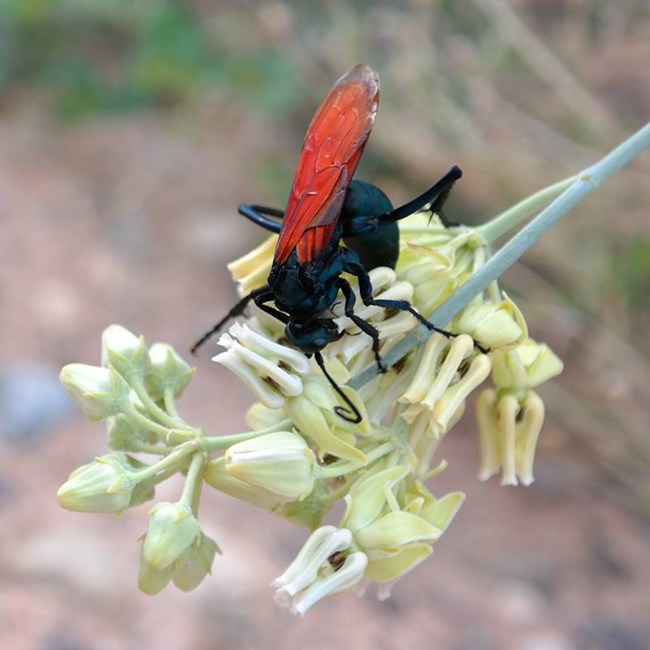
Stop 2: Pollinator Garden
In spring and summer, our pollinator garden is vibrant with fragrant flowers. Each plant growing here provides food and habitat for bees, butterflies, birds, bats, and other pollinators.
A pollinator is anything that helps carry pollen from the male part of a flower (stamen) to the female part (stigma). Pollination must occur for the plant to be fertilized and produce fruits, seeds, and young plants. Some pollinators intentionally collect pollen. Others move pollen accidentally. It sticks to their bodies while they are feeding and is transported from flower to flower, resulting in pollination.
Pollinators help keep more than 75% of Earth's flowering plants alive. This amounts to more than 1,200 food crops and 180,000 species that help stabilize our soils, clean our air, supply oxygen, and support wildlife. One out of every three bites of food you eat exists because of pollinators.
Pollinator populations are declining around the world, largely due to loss of their habitat and food sources. As habitats are fragmented, many become too small to meet the needs of pollinators. Native plants or wildflowers needed by pollinators are often outcompeted by non-native species. Pesticide use is also a concern.
Even small changes in our own backyards can help pollinators survive and thrive. Tips to consider:
-
Provide pollinator habitat by planting native flowers that bloom at different times. Many pollinators (such as the monarch butterfly) are migratory, and pollinator gardens can provide critical “stopover” habitat as they complete their migrations.
- Place a shallow dish of water on your deck or window sill to help thirsty pollinators stay hydrated. Place several semi-submerged stones in the water dish so they can drink without running the risk of drowning.
-
Limit the use of pesticides. Pollinators can be harmed if they consume nectar or pollen that has come into contact with pesticides. Before using a pesticide, ask yourself: Are flowers in bloom or are pollinators active? Are there alternatives to using the pesticide? Am I applying the pesticide according to the instructions? You can also help reduce the risk of exposure by applying pesticides at night, when bees and other pollinators are inactive.
- Ensure that different types of pollinators visit your yard by planting flowers of different shapes, sizes, and colors. Planting flowers in clumps makes it easier for pollinators to locate their next meal.
- Provide nesting and sheltering sites. Different types of pollinators require different things. Potential nesting sites include trees (both living and dead), shrubs, brush piles, bare ground, and bee boxes.
- The North American Pollinator Protection Campaign offers free planting guides customized by region. These guides make it easy to figure out what you can plant to promote healthy pollinator habitat. All you need is your five-digit zip code!
- butterfly bush (Buddleia marrubifolia)
- candy barrel cactus (Ferocactus wislizeni)
- chuparosa (Justicia californica)
- desert lavender (Hyptis emoryi)
- desert marigold (Baileya multiradiata)
- fairy duster (Calliandra eriophylla)
- fleabane (Erigeron spp.)
- trailing dalea (Dalea greggii)
- whitestem milkweed (Asclepias albicans)
- yellow bells (Tecoma stans)
- brittlebush (Encelia farinosa)
- desert willow (Chilopsis linearis)
- Graham's nipple cactus (Mammillaria grahamii)
- mesquite mistletoe (Phoradendron californicum)
- ocotillo (Fouquieria splendens)
- teddy bear cholla (Cylindropuntia bigelovii)
- yellow palo verde (Parkinsonia microphylla)
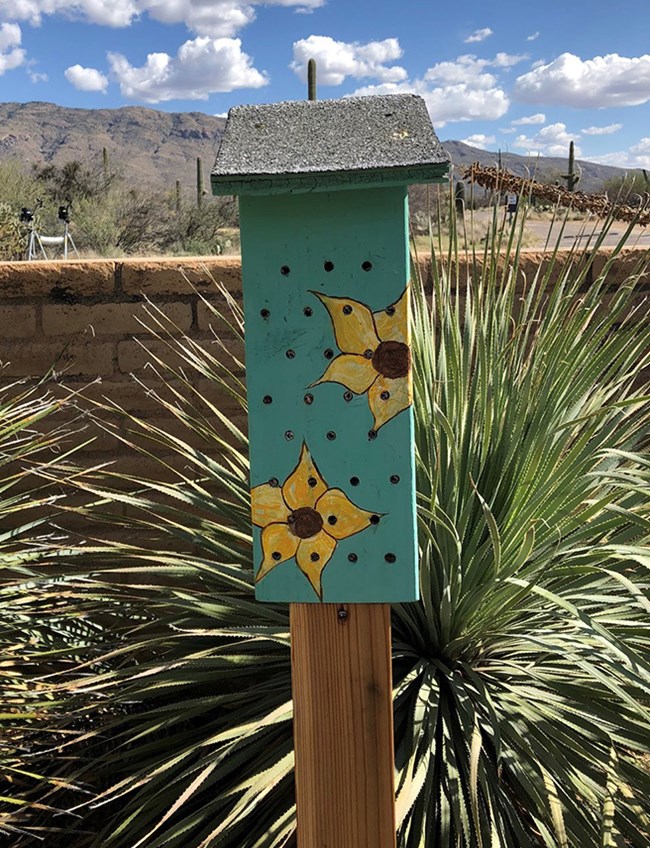
Stop 3: Bee Boxes
Bee boxes provide nesting space and shelter for pollinator. They are easy to make but can also be purchased fairly cheaply. Minimal routine maintenance is required. For information, search the internet for "native bee boxes" or "native bee house."
The Sonoran Desert is home to about 1,000 of the estimated 20,000 bee species on Earth, from the tiny Perdita minima (less than .08 in/2 mm) to hefty carpenter bees (Xylocopa, 1.5 inches/40 mm). In fact, the area around Tucson is thought to have one of the world’s most diverse bee populations, with at least 45 genera in 7 families. Sonoran Desert bees typically nest in underground burrows, hollow plant remains, or in tunnels abandoned by wood-boring beetles. Adult bees typically emerge in spring or summer, at a rate of one generation per year.
A bee will rarely sting when it is foraging on pollen, nectar, or water. However, a bee may sting if it is handled roughly (swatted at or stepped on), or feels alarmed in any way. Generally, if you leave a bee alone, it will leave you alone.
In addition to providing pollinator gardens and bee boxes, you can help Sonoran Desert bees by knowing the difference between bees and their less-friendly relations, yellowjackets and wasps. Here are some ways to tell the difference:
- Bees have plump, furry bodies. Hornets, yellowjackets, and wasps have smooth, skinnier bodies.
- When bees fly, their legs are generally not visible. When hornets, yellowjackets, and wasps fly, two thin, long legs can be seen hanging down from their bodies.
- Most bees are non-aggressive. Hornets, yellowjackets, wasps, and Africanized bees are typically more aggressive.

In these photos, the furry body of the bee (left) is easy to distinguish from the smooth, hairless body of the yellowjacket (middle), and the thinner body of the wasp (right). Photos: USGS/J. Giersch
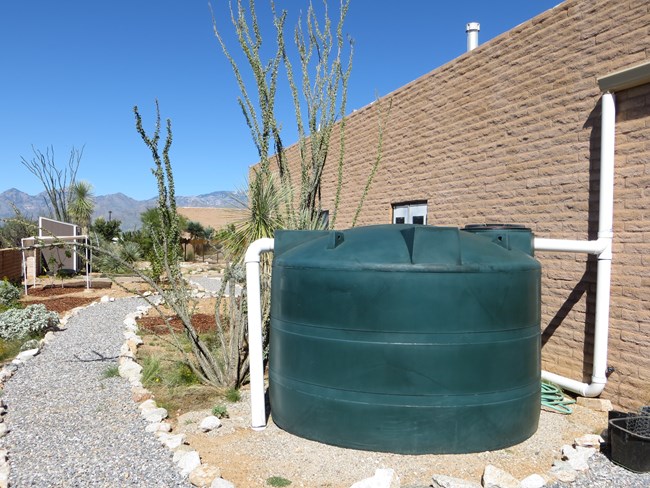
Stop 4: Water Harvesting
All of the water used on the DRLC grounds is harvested from the sky. This 1,400-gallon plastic storage tank collects rainwater from the roof via raingutters. The tank fills quickly during even a small rainshower, with the overflow filling the landscape basins. The first 30 gallons of rainwater are diverted into the piping below to reduce dust and other contaminants inside the tank. Nearby plants are watered using a garden hose attached to the tank.
This process conserves water and ensures that it gets to where it’s needed, when it’s needed. In Arizona, with an average of 13 inches of precipitation per year, a 2,500 square-foot rooftop can collect about 20,000 gallons of fresh rainwater annually.
Rainwater harvesting can reduce your water bill. It can also reduce the need for groundwater pumping—which, in the words of water-policy expert Robert Glennon, causes water bodies, wells, and “wetlands to dry up; the ground beneath us to collapse; and fish, wildlife, and trees to die."
- Harvest your own rainwater. A rainwater harvesting system consists of three basic elements: a collection area, a conveyance system, and storage facilities. The collection area in most cases is the roof. The City of Tucson offers rainwater harvesting rebates on qualifying systems. The city also operates a rainwater harvesting grant/loan program. In addition, individuals may claim a tax credit up to $1,000 for installing a rainwater harvesting system in Arizona. Other helpful sources of information include the Watershed Management Group, the Arizona Municipal Water Users Association, the University of Arizona, and the Arizona Department of Water Resources.
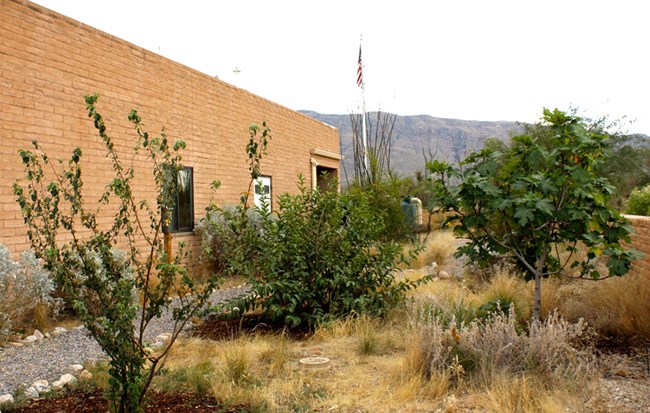
Stop 5: Heritage Orchard
In the late 17th and early 18th centuries, Catholic missionaries introduced a variety of fruit trees to the Sonoran Desert. The Mission San José de Tumacácori (now Tumacácori National Historical Park, about 60 miles south of the DRLC) featured an orchard of peach, quince, pear, apple, pecan, walnut, fig, and pomegranate trees.
The trees in our small orchard are part of a broader project to identify stocks from the trees introduced by missionaries and plant them in “heritage orchards.” Heritage orchards like this one commemorate a pivotal time in Arizona history. But they are also complex living reminders of how colonialism remains written on the Southwestern landscape.
Want to plant your own history? Mission-heritage fruit trees are available from local nurseries, thanks to our partners at the Arizona-Sonora Desert Museum and Desert Survivors, who have investigated their origins, collected cuttings, and cultivated them. Another local program, Native Seeds/SEARCH, operates a seed bank that “represents the cultural heritage and farming knowledge of over 50 indigenous communities, as well as recent immigrants,” including the Spanish missionaries. Some of these crops can be found in our sustainable foods garden, at Stop 9.
- Eusebio Francisco Kino
- The Significance of Spanish Colonial Missions in our National Story and our Common Heritage with Spain, Mexico and Latin America
- Tohono O’odham History
- Series: Native Peoples of the Sonoran Desert
- Historic Resource Study, Tumacacori National Historical Park
- Colonialism: John Smith in Context
- Prehistoric irrigation canals of the Salt River Valley (map by Watershed Management Group)
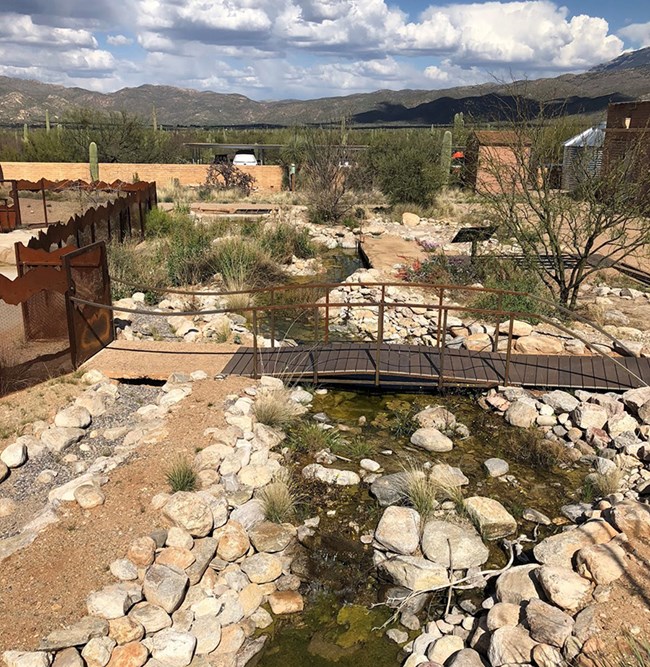
Stop 6: Water Features
The DRLC’s artificial stream and tinaja provide habitat for sensitive and threatened animals and plants, some of which can then be transplanted into national parks and other protected lands. Here, visitors can learn about water features and the aquatic organisms that depend on them. Professional and citizen scientists use this space to learn monitoring techniques for water quantity, water quality, and other attributes of wildland waters.
The DRLC water features are a closed system. Harvested rainwater is piped from the nearby steel cistern into each habitat, where it is then recirculated through that same habitat. Water lost to evaporation is replaced by more water from the cistern. In each water feature, dropping water levels will trigger a float valve. The valve then opens, adding stored rainwater to the feature. During rare times when the cistern is empty, the system automatically switches over to the municipal water system, ensuring that our aquatic species can survive and thrive.
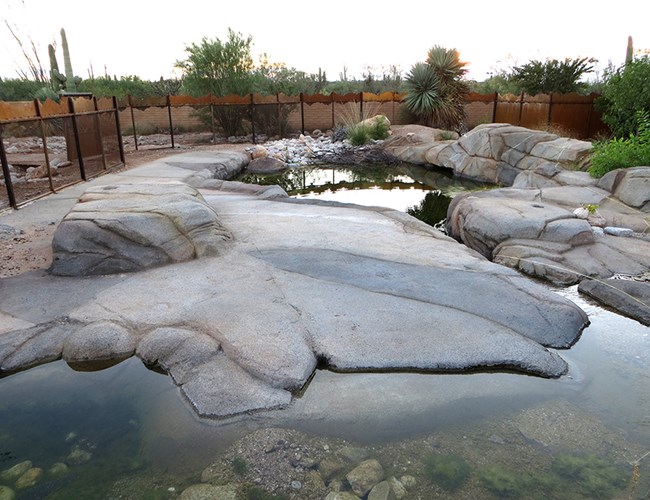
Stop 7: Tinaja Habitat
“Tinaja” is Spanish for “little jar.” Tinajas are perennial and semi-perennial bedrock pools, scoured out by water, sand, and gravel over time. They are important sources of water and habitat for plants and animals, especially during the dry season. Humans have used tinajas for hundreds (possibly thousands) of years, including ancient Hohokam and present-day Tohono O’odham peoples as well as Mexican, Spanish, and American ranchers. Tinajas are threatened by urban sprawl and suburban development, groundwater depletion, wildfires exacerbated by invasive species (buffelgrass), and changing climate patterns.
The DRLC’s artificial tinaja is lined with heavy rubber and covered with recycled concrete. The concrete was sprayed with a coating of cement plaster, which was carved and painted to match local geology. It is fed by stored rainwater that is circulated by a pump (more on this at Stop 10). More than 1,000 hours of volunteer work from local students and visitors made this habitat possible.
The distinctive fence around the tinaja is designed to prevent American bullfrogs from getting in. Although native to the eastern US, American bullfrogs are invasive in the Southwest. They are drawn to calm perennial waters, such as ponds. These voracious predators have led to the decline and localized extinction of native garter snakes and frogs, such as lowland leopard frogs and Chiricahua leopard frogs. They also spread chytrid fungus, which can wipe out whole populations of native fish and frogs.
- Help reduce the need for groundwater pumping by conserving water. Things to do include harvesting rainwater, xeriscaping with native plants, checking your home and irrigation system for leaks, and investing in water-efficient showerheads and other appliances.
- Never release unwanted pet frogs or science projects into the wild.
- Do not purchase bullfrogs at any life stage.
- Help keep this tinaja bullfrog-free by making sure the gate closes behind you.
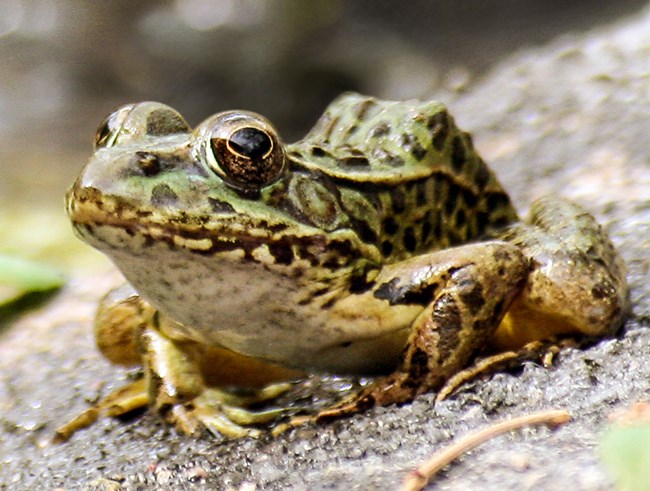
Stop 8: Tinaja Species
Lowland Leopard Frog
The lowland leopard frog (Rana yavapaiensis) is a native frog that depends on desert waters. It has declined in the Desert Southwest and is considered a species of special conservation concern. In the Sonoran Desert, lowland leopard frogs live in places with permanent water, such as canyon pools and streams. They breed year-round, and tadpoles take a year or more to reach adulthood. This small frog (1.8–3.4 in) is tan, brown, and light green to bright green. It typically has large dark spots on its back but no spots on the head in front of the eyes. Its underside is yellowish. Adults eat mostly insects and other invertebrates. Tadpoles feed on algae and other plant tissue.
Lowland leopard frogs are an indicator species of ecosystem health, and measures to protect them will benefit the many other animals that rely on desert water sources. It is illegal to collect lowland leopard frogs in Arizona without a permit for scientific collection or similar purpose.
Conservation status: Species of Concern
Threats: Introduction of non-native frogs and fishes (in particular predatory fish, crayfish, and American bullfrogs), habitat alteration, population isolation, toxicants, disease, parasites

Rio Sonoyta Pupfish (aka Quitobaquito Pupfish)
Rio Sonoyta pupfish and Quitobaquito pupfish are two subpopulations of the endangered species, Cyprinodon eremus. Once ranging from northern Mexico to the lower Colorado River in Arizona and even into California, these fish are now found naturally in only two water bodies: Rio Sonoyta, in Sonora, and Quitobaquito Springs, in Organ Pipe Cactus National Monument. The fish at the DRLC originated in Rio Sonoyta.
These fish are small (1.5–2 inches long) but resilient, capable of withstanding temperatures up to 113°F, low dissolved oxygen content, and waters twice as salty as the sea. Rio Sonoyta pupfish are omnivorous. They feed on small invertebrates (such as mosquito larvae), aquatic plants, and algae. When defending their territory and seeking to mate, the males change color, becoming a vibrant blue. Their lifespan is around two years.
Conservation status: Endangered
Threats: Habitat loss and fragmentation, groundwater pumping, pesticides, exotic invasive species

Stop 9: Sustainable Foods Garden
The goal of sustainable gardening is to produce crops with minimal impact to the environment. Sustainable gardens typically use organic fertilizer to grow locally native plants. Water is harvested from the sky. Purposeful garden design is used to conserve water. Seeds are gathered from the garden plants and stored for future use.
The DRLC garden is watered using drip-irrigation lines and olla (“oh-yah”) pots. The irrigation lines emit water at the base of the plants, so the soil can absorb it directly. This helps prevent water loss to evaporation. Olla pots, made of porous clay, allow water to be released only as needed. When the surrounding soil dries, the roots of water-seeking plants create suction that pulls water out of the olla. This method of watering has significantly reduced the amount of water needed for the garden.
Seeds for this garden were provided by Native Seeds/SEARCH, a Tucson-based non-profit seed conservation organization. Our staff harvests new seeds from each crop for future use in this garden and for distribution to visitors. If you are interested in obtaining seeds, please ask our staff.
Plants grown in summer (Late April–August) include melons, squash, corn, beans, and chilies. Ancient Sonoran Desert people planted corn, beans, and squash together. Not only did the plants help each other grow, but together, they were the basis of a balanced, healthy diet. The tall corn stalks provide a support for the beans. Large squash leaves protect the soil from losing moisture through evaporation. The beans fix nitrogen to help fertilize the soil.
Many herbs, greens, and wheat were introduced to the Americas after Europeans arrived. Although they are not necessarily native, they are climate-adapted and provide extra foods during this lean time of the year. Many of these plants are continuously harvested throughout the season. Swiss chard, mustard greens, dill, and broccoli are just some of the crops that have fed staff and organizations who work with the Desert Research Learning Center.
- Garden with native desert plants, which require less water than non-natives.
- Harvest any seeds you have and share them with your community.
- Ask one of our staff members if there are currently any seeds available for public distribution.
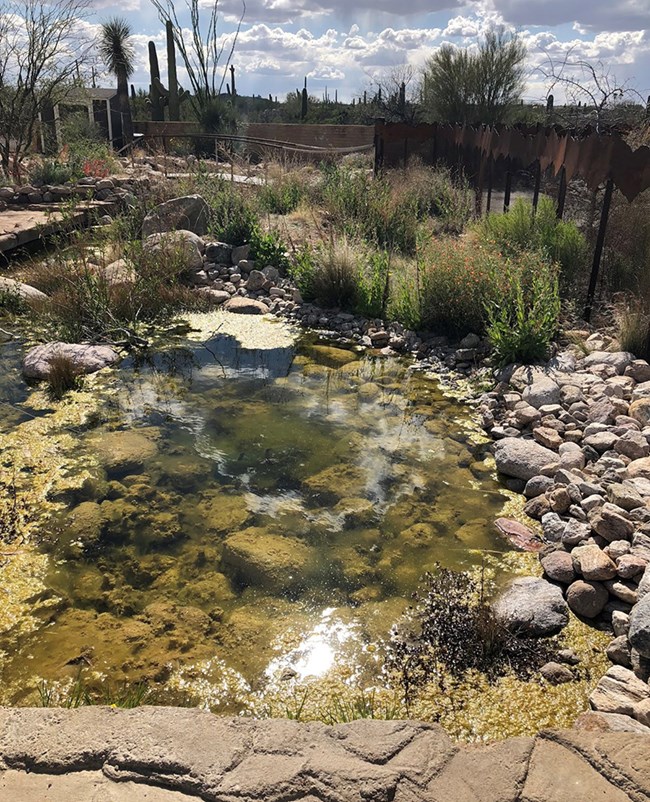
Stop 10: Stream Habitat
This artificial stream provides habitat for species that prefer flowing water to still water. Stream water is typically cooler, clearer, and contains more oxygen than pond water, and some fish feed by facing upstream and catching what flows by. Especially in the desert, where water is rare, the importance of stream systems extends far beyond their relatively small area. They provide critical habitat, food, and shelter for wildlife, reduce damage from floods, are sources of drinking water, filter pollutants, and support economically important recreational and commercial uses.
This stream is lined with rubber. It is fed with rainwater stored in a steel water tank nearby. A pump generates flow and the water is recirculated. The stream channel is six feet deep in some locations. These deep areas are stacked with rock-covered crates. The crates provide suitable habitat for desert-dwelling fish and enable the stream to meet local safety standards for artificial water bodies.
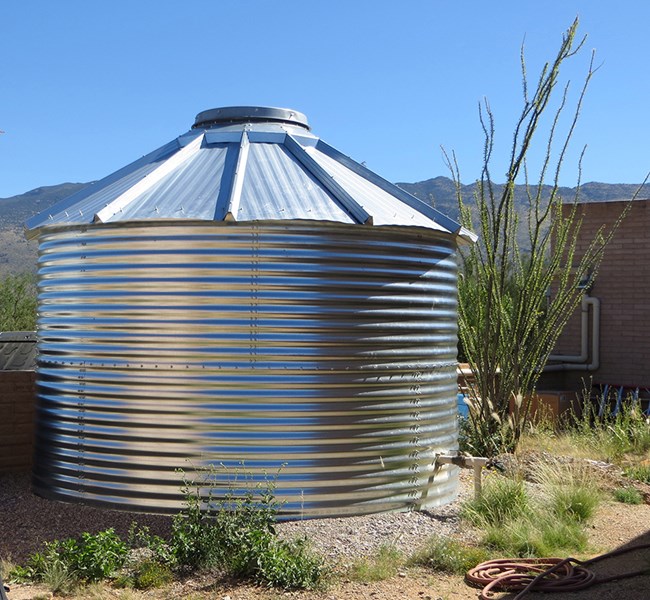
Stop 11: Water Harvesting
This second cistern supports the water features and provides irrigation for the landscaping. It is made of galvanized steel with a heavy polyethylene liner. It holds 6,500 gallons of water, also collected from the roof of the DRLC. A set of underground pipes connects it to the tinaja and stream, where an electric pump circulates the water through the features. The stored rainwater also supports native landscaping plants, gardens, and the heritage orchard via a drip irrigation system.
Harvesting rain when it falls and saving it for later use is a powerful tool against drought. Since 1980, drought has cost the U.S. economy about $226 billion. Of all disasters related to weather and climate, only hurricanes have been costlier.
Climate models are uncertain about future precipitation patterns. What we do know is that higher temperatures increase both water demand and evaporation—and that many areas, including Tucson, are already exceeding the range of natural variability for extreme warm temperatures.
- Plant native plants.
- Use native landscaping materials.
- Water early or late in the day.
- Consider installing an active (cistern) water-harvesting system at your home or business.
Drought can be hard to define. Generally speaking, it is a lack of water significant enough to affect plants, animals, and people at a broad scale. Drought can occur when overall annual precipitation is less than normal. But it can also happen when precipitation doesn’t fall at the usual times of year, making it unavailable when it's most needed. Warm temperatures may cause rain to fall instead of snow, reducing snowpack that usually provides water later in the summer. Or growing human demand for water may be greater than the ability of the climate to provide it, even under historically normal climatic conditions. The Sonoran Desert Network monitors both climate and water resources. Because they are so closely intertwined, we report on their status and trends together.
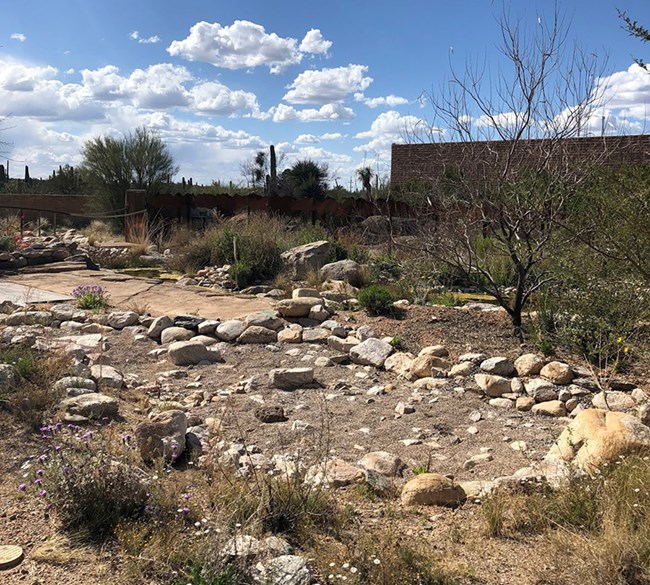
Stop 12: Water Catchment Basins
Rainwater harvesting has been practiced for centuries. It can be as simple as creating berms and basins in your landscape. By slowing the flow of water and directing it to spread across your yard or garden, you can maximize the benefit of rainfall without installing a catchment and storage system. At the same time, you’ll reduce uncontrolled flow, which can carry off topsoil and create gullies, worsening erosion and degrading water quality.
This basin traps rainwater and runoff and allows the water to permeate into the ground instead of quickly flowing over it. This is called groundwater recharging, because it allows water to be stored in the soil itself. Groundwater recharging is most commonly done by constructing a series of berms, which are short walls designed to prevent sheetflow. Berms are generally built to follow the contour of the land. They can be earthen or made of rock. When rain falls, it is trapped inside the walls of the berm, where it can permeate the soil instead of swiftly flowing across it.
A key feature of effective basins is mulch. Mulch is a permeable material that can hold water like a sponge. It is often made of cast-off leaves, shredded bark, compost, or other organic materials. It can also consist of loose gravel. Organic mulches also provide important nutrients to landscape plants as they decay. They periodically need to be replenished due to this decomposition.
- Construct simple basins around vegetation in your yard. Just a moderate effort with a shovel and rake can provide huge benefits to vegetation.
- Plant low water-use native plants that are adapted to your local climate.
- Invest in mulches to enhance the efficiency of your basins.
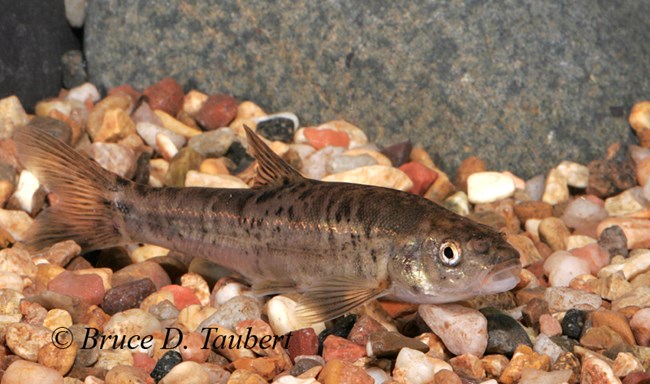
Photo by Bruce Taubert, courtesy Arizona Game and Fish Department
Stop 13: Stream Species
Speckled Dace
Depending on where you are in Arizona, the speckled dace (Rhinichthys osculus) looks different. In the southern part of the Gila River system, they are small, with lots of speckles or blotches, and chubby-bodied. North of the Mogollon Rim, they are larger, may or may not have bands, and their shape is more streamlined. They can grow up to three inches (7.6 cm) long on a diet of algae and other plants, small crustaceans, insect larvae, and small snails. Speckled dace are bottom dwellers found in smaller, shallow rivers. They don’t do well in water with high temperature or low oxygen content.
Conservation status: Least Concern
Threats: Non-native predatory fish
Desert Sucker
The desert sucker (Catostomus clarki) uses a cartilage ridge below its lower lip to scrape food from the bottom of stream channels. It feeds on diatoms, algae, and any small animals that happen to be within the algae. Juveniles eat small aquatic insects, such as midge and blackfly larvae. Desert suckers typically grow to 13 inches (33 cm) in length. They are abundant in the Bill Williams, Gila, Salt, and Verde river systems. They require streamflow, as opposed to lake conditions, and prefer waters that include quiet pools with gravelly or rocky bottoms.
Conservation status: Least Concern
Threats: Loss of habitat and food sources through alteration of flow regimes and construction of reservoirs; non-native fish stocking.
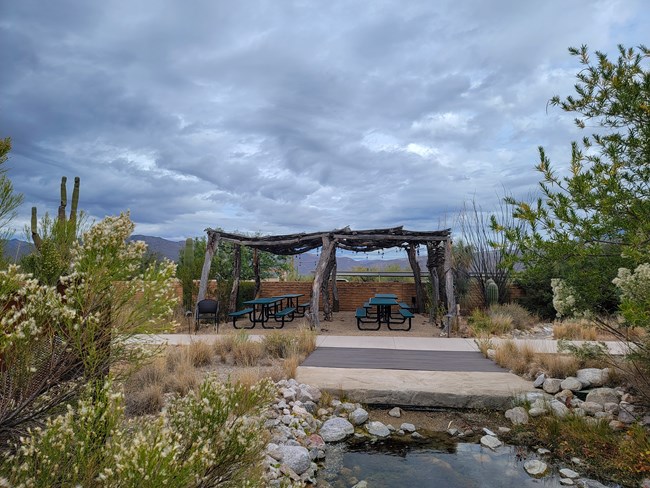
NPS/E. Schnaubelt
Stop 14: Ramadas
Shading the picnic tables beside the stream and tinaja is an ocotillo ramada, inspired by local indigenous peoples’ wa:ato (O’odham word for mesquite ramada).
Historically, the indigenous groups of the Southwest used ramadas to provide shade in the desert. The use of ramadas ranged greatly. Some wa:atos were long-term structures, commonly standing outside of a ki (O’odham word for house). During the summer, the puddled adobe and pit houses would get too hot indoors, so most household activities, such as cooking and sleeping, would take place outside under the wa:ato. (Conversely, in the winter, the warmth of the ki was ideal so these activities took place indoors.)
Our ramada closely resembles the appearance of a wa:ato but we chose to make a few differences to the design to make the structure taller, longer-lasting, and sturdier. For example, the legs are posted into cement and fortified with rebar. Additionally, we used tamarisk for the legs instead of mesquite, as is traditional. However, our ramada does have an ocotillo roof as common for a wa:ato.
This is the end of the tour. You may retrace your steps to the front of the building or exit through the gate near the cistern at the northeast corner of the main building.
